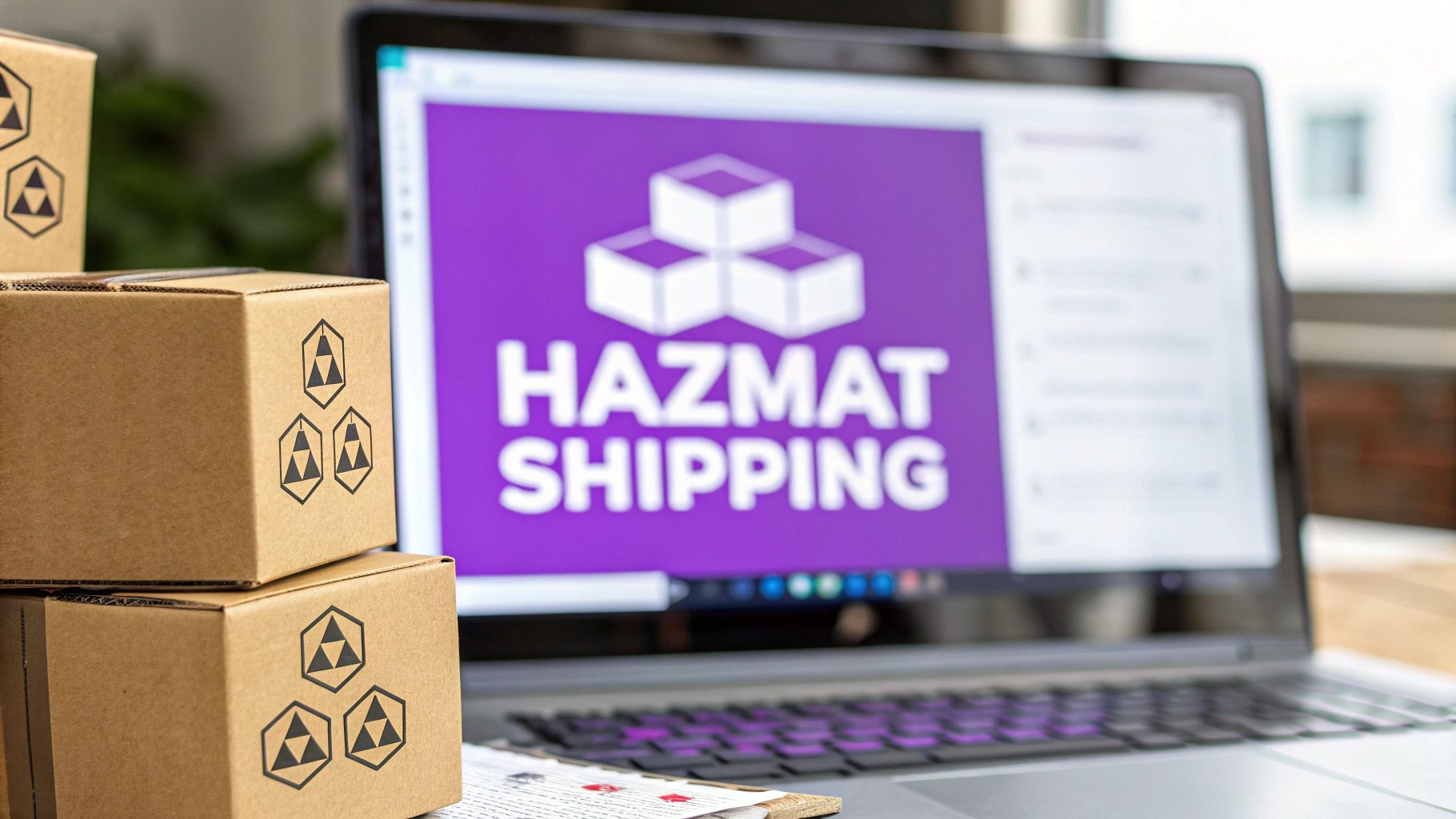
Managing Hazmat Shipping Restrictions in WooCommerce
Learn how to manage Hazmat shipping restrictions in WooCommerce. Discover compliance tips and setup strategies for a compliant store.
Cody Y.
Updated on Aug 31, 2025
Getting your hazmat shipping rules right in WooCommerce isn't just a "best practice"—it's a core requirement for keeping your business safe and operational. If you're selling anything from perfumes to products with lithium batteries, ignoring these regulations can lead to steep fines, suspended carrier accounts, and serious legal trouble.
Why You Must Master Hazmat Shipping in WooCommerce
Treating hazardous material (hazmat) shipping rules as an afterthought is a massive business risk. You’d be surprised how many online store owners are unknowingly shipping regulated items every single day.
Common e-commerce products like perfumes, nail polish, certain cleaning supplies, and just about any electronic device with a lithium battery fall under strict shipping regulations. These rules dictate exactly how and where they can be transported, and getting it wrong is not an option.
The consequences go way beyond a simple returned package. We're talking about direct threats to your business's bottom line and hard-earned reputation.
The Real-World Risks of Non-Compliance
Failing to properly manage your hazmat shipping can set off a chain reaction of costly problems. Carriers like UPS, FedEx, and USPS have gotten incredibly good at detecting undeclared dangerous goods, and they don't take violations lightly.
Here's what's at stake:
- Steep Carrier Fines: Penalties can easily hit thousands of dollars for a single incident.
- Account Suspension: Repeated mistakes will get your shipping account suspended or even shut down for good, effectively grinding your fulfillment to a halt.
- Legal Liability: If an accident happens because of an improperly shipped item, your business could face devastating lawsuits and regulatory action.
- Damaged Reputation: One public safety incident can destroy customer trust that took you years to build.
As e-commerce continues to grow, so does the scrutiny from carriers and regulators. They're watching more closely than ever.
Before you can build your shipping rules, you need to know which of your products are actually considered hazmat. Many everyday items fall under these regulations, and recognizing them is the first step toward compliance.
Common E-commerce Products Classified as Hazmat
| Product Category | Examples | Primary Hazard |
|---|---|---|
| Beauty & Cosmetics | Perfumes, colognes, nail polish, aerosol hairspray, some lotions | Flammable Liquid/Gas |
| Electronics | Laptops, smartphones, power banks, drones, electric toothbrushes | Lithium Batteries |
| Household Goods | Cleaning solutions (bleach, ammonia), aerosol air fresheners, drain cleaners | Corrosive, Flammable |
| Health & Wellness | Hand sanitizer (alcohol-based), certain first aid kits, rubbing alcohol | Flammable Liquid |
| Hobby & Craft | Adhesives, spray paints, certain epoxies, lighter fluid | Flammable, Toxic |
| Outdoor & Sporting | Camping fuel, flares, bear spray, ammunition | Flammable, Explosive |
This table isn't exhaustive, but it highlights just how common regulated goods are in online retail. If you sell anything on this list, you need a hazmat shipping strategy.
The growth of e-commerce, including platforms like WooCommerce, has significantly increased the shipment of hazardous materials (hazmat), necessitating enhanced management of shipping restrictions due to safety and regulatory concerns. Hazmat shipments represent approximately 10-15% of all freight shipments worldwide, but they carry a disproportionately high risk. Discover more insights about future transportation trends at Hazmat University.
From Risk Management to Business Advantage
Putting a solid hazmat shipping strategy in place is about more than just dodging penalties. It’s about building a resilient, trustworthy business.
When you implement clear rules, you’re not only protecting your store from financial and legal fallout. You’re also ensuring the safety of everyone in the supply chain—from your warehouse team to the delivery drivers and, of course, your customers.
Think of this guide as your roadmap. We’ll show you how to turn a complex challenge into a real competitive edge, so you can sell regulated goods with complete confidence.
Decoding the Complex World of Hazmat Regulations
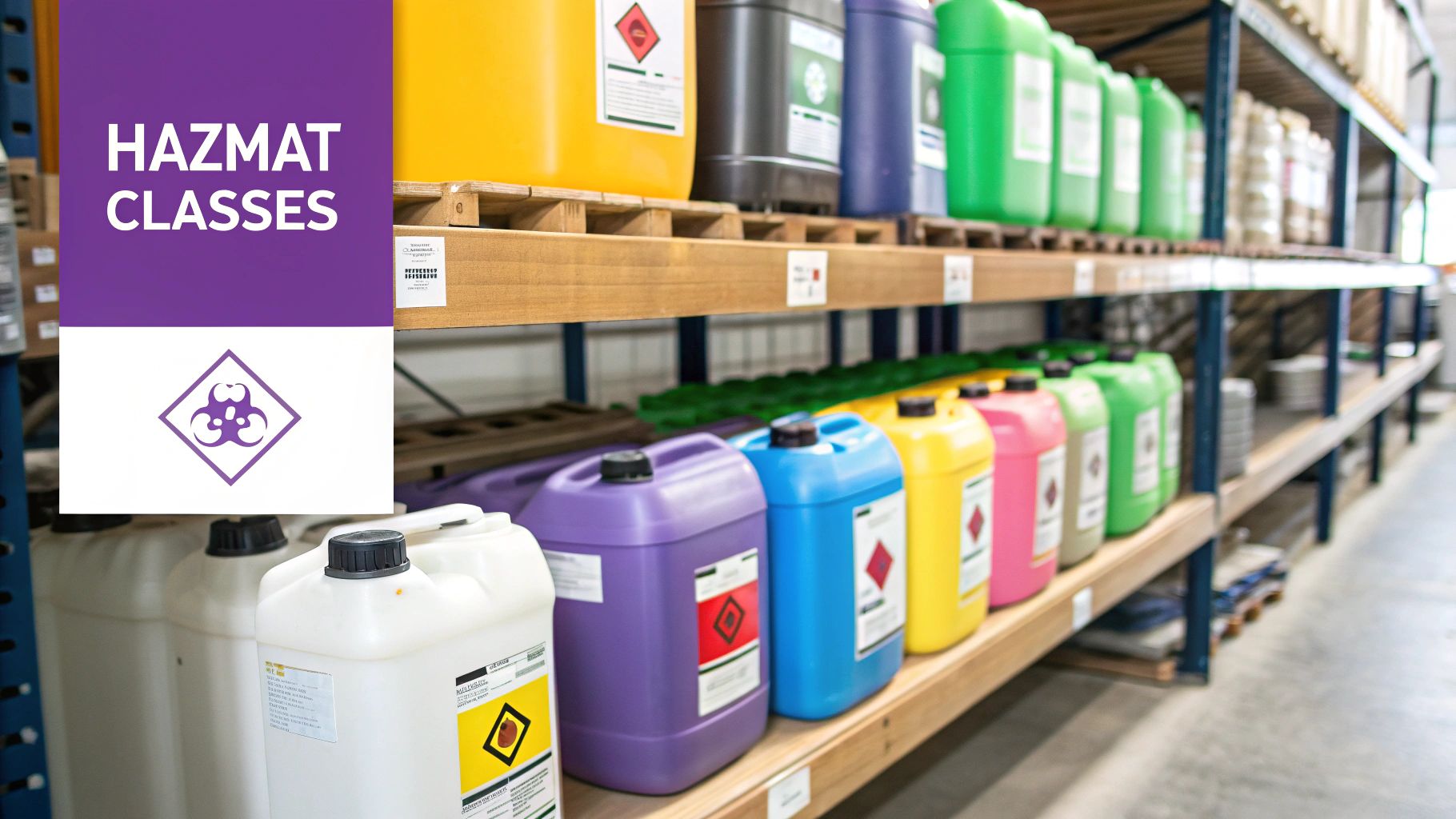
Before you touch a single setting in your WooCommerce store, you need to get a handle on the rules of the road—and the air, and the sea. Hazmat shipping is a tangled web of regulations from different agencies, each with its own acronyms and rulebooks. Getting these straight is the first, most critical step in building a shipping strategy that won't get you into trouble.
Think of it like this: you wouldn't use a road map to navigate the ocean. In the same way, you can't apply ground shipping rules to air cargo. This single distinction is the reason behind many of the shipping restrictions you see every day.
The Key Regulatory Players
For any e-commerce store based in the U.S., two main sets of regulations will dictate your shipping policies. Knowing who they are and what they do is crucial for managing hazmat shipping restrictions in WooCommerce without losing your mind.
- DOT HMR (Department of Transportation Hazardous Materials Regulations): This is your foundational rulebook for all domestic hazmat shipments inside the United States. It covers ground, rail, air, and sea, defining what a hazardous material is and setting the standards for how it must be packed, labeled, and handled.
- IATA DGR (International Air Transport Association Dangerous Goods Regulations): If you ship anything by air—domestically or internationally—you have to follow IATA's much stricter rules. These regulations are built to manage the unique risks of air transport, like massive pressure and temperature changes.
A classic example I see all the time is perfume. A simple bottle of perfume is considered a flammable liquid. Under DOT HMR, you can often ship it via ground service with the right label and box. But try to send that same bottle by air, and it suddenly falls under the intense scrutiny of IATA DGR. This often requires special permits, packaging, and carrier agreements that just aren't practical for most online stores.
This is exactly why you'll see so many shops restrict fragrances and similar items to "Ground Shipping Only."
"The 'why' behind your shipping rules is just as important as the 'how.' Understanding that air and ground transport have fundamentally different risk profiles helps you make smarter, safer decisions for your business and your customers."
The image below shows the cover of the IATA Dangerous Goods Regulations manual. For anyone shipping by air, this document is the global gold standard for compliance.

Airlines all over the world rely on this manual to make sure dangerous goods are transported safely and efficiently.
Navigating International Complexity
Things get really tricky when you start shipping across borders. For most stores, the biggest headache in managing hazmat shipping in WooCommerce is the sheer complexity of international laws.
Globally, you're looking at over 50 different regulatory systems for hazardous materials, including Europe's ADR (European Agreement concerning the International Carriage of Dangerous Goods by Road). With a staggering 70% of global hazmat shipments crossing international lines, your store's rules have to be smart enough to handle this patchwork of laws, or you'll face fines and seized shipments.
This isn't just a hazmat problem. We see the same challenges with other regulated products. For example, our guide on WooCommerce alcohol shipping restrictions dives into how state-by-state laws create a similar compliance maze.
The bottom line is that your WooCommerce setup needs to be flexible enough to handle these geographic curveballs, whether they’re based on the product type or its final destination.
How to Classify Hazmat Products in Your Store
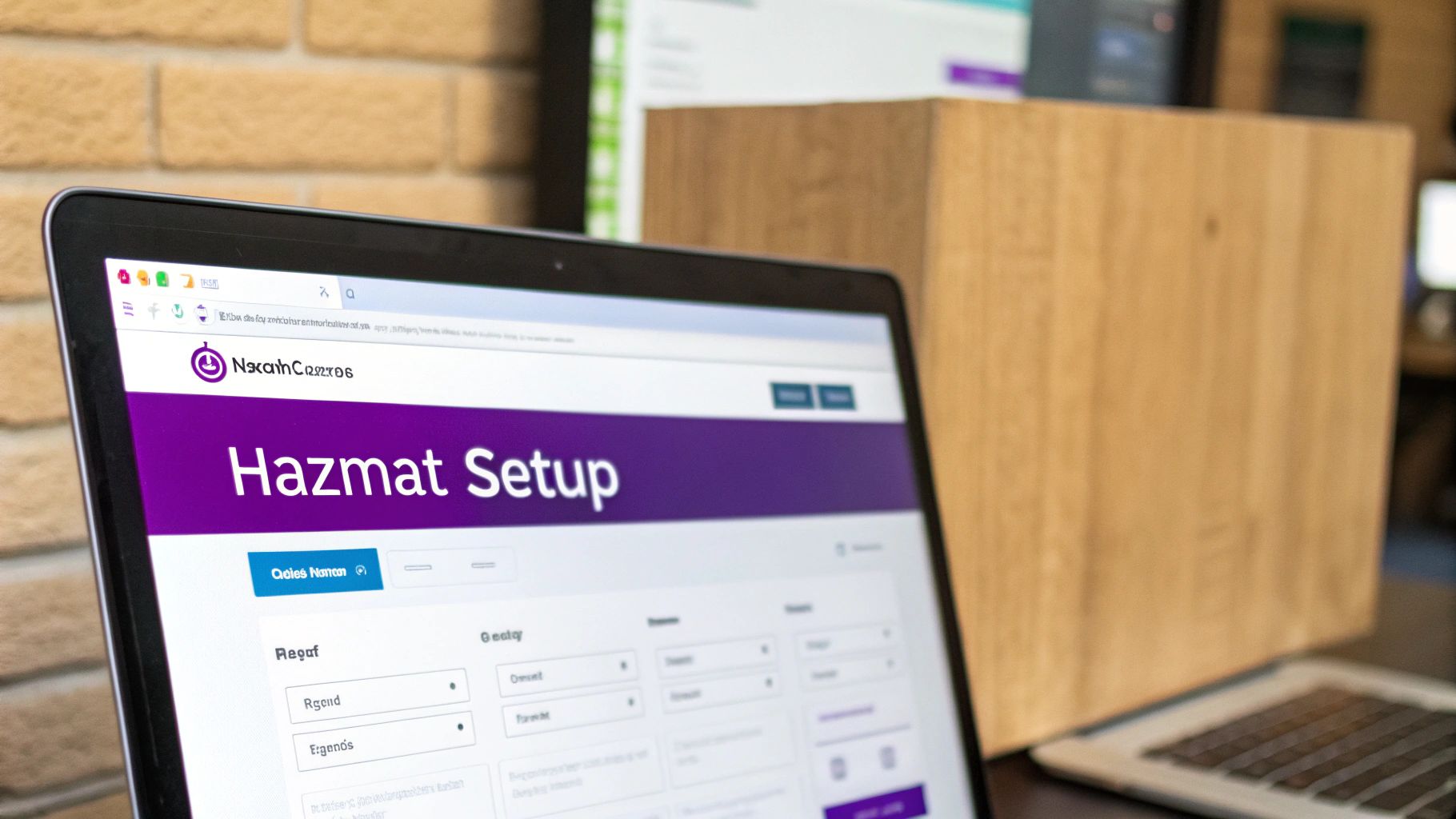
Your entire compliance strategy hinges on one thing: correctly identifying which of your products are hazardous. Before you can build a single shipping rule, you need a bulletproof way to flag these regulated items within your WooCommerce inventory. Without this crucial step, any automation you build is just guesswork.
The good news is that you can build a solid foundation using WooCommerce’s native features. This internal classification becomes the trigger for all your automated shipping rules, telling your system which products need special handling at checkout. We’ll focus on using product attributes, as they offer the most flexibility.
Creating a Hazmat Status Attribute
Think of a product attribute as a simple, powerful data tag. By creating a custom attribute, you can give every product in your catalog a clear hazmat designation that your shipping plugin can instantly recognize.
Here’s the quick way to set it up:
- Head over to Products > Attributes in your WordPress dashboard.
- In the "Add new attribute" section, enter a name like "Hazmat Status" or "Shipping Class."
- Click "Add attribute" to save it.
- Now, click on the new attribute's name in the list to configure its terms. These are the specific values you'll assign to products.
For the terms, you want to be descriptive enough to be useful but simple enough to manage. For instance, you could create terms like:
- Flammable Liquid: Perfect for perfumes, nail polish, or alcohol-based sanitizers.
- Lithium Battery: For electronics like laptops, power banks, and smartphones.
- Corrosive: Useful for certain potent cleaning supplies.
- Aerosol: Covers items like hairspray or spray paints.
- Non-Hazmat: A default term for everything else in your catalog.
Once these terms are configured, you can edit any product, go to the "Product data" section, click the "Attributes" tab, and assign the correct Hazmat Status. This simple tag is what unlocks the power of automated shipping restrictions.
Handling Variable Products and Auditing Your Catalog
Variable products, like a phone available in different colors, require careful attention. Make sure you apply the "Lithium Battery" attribute to the parent product so that every variation inherits the restriction. Forgetting this is a common oversight that leads to compliance gaps.
Auditing your existing catalog is just as important. Go through your inventory with a critical eye, especially if you have hundreds or thousands of SKUs. Look for trigger words in product descriptions like "aerosol," "alcohol-based," or "battery included."
The goal is to build a system where product classification becomes a standard part of your workflow for adding new items. This proactive approach prevents compliance issues before they ever have a chance to impact a customer's order.
This classification process is fundamental for many types of regulated goods, not just traditional hazmat. For instance, our guide on PACT Act compliance for vape and tobacco shipping in WooCommerce relies on similar product-level tagging to enforce complex state and local rules. The principle is the same: first, you classify; then, you restrict.
With your products properly classified, it's time to put that hard work to use. This is where you translate those product attributes into smart, automated shipping rules that do the heavy lifting for you. The whole point is to build a system that enforces compliance at checkout, automatically, so you can focus on selling.
This whole process boils down to three core ideas: identifying what a product is, applying the right shipping rules in WooCommerce, and then testing everything to make sure it works as expected.
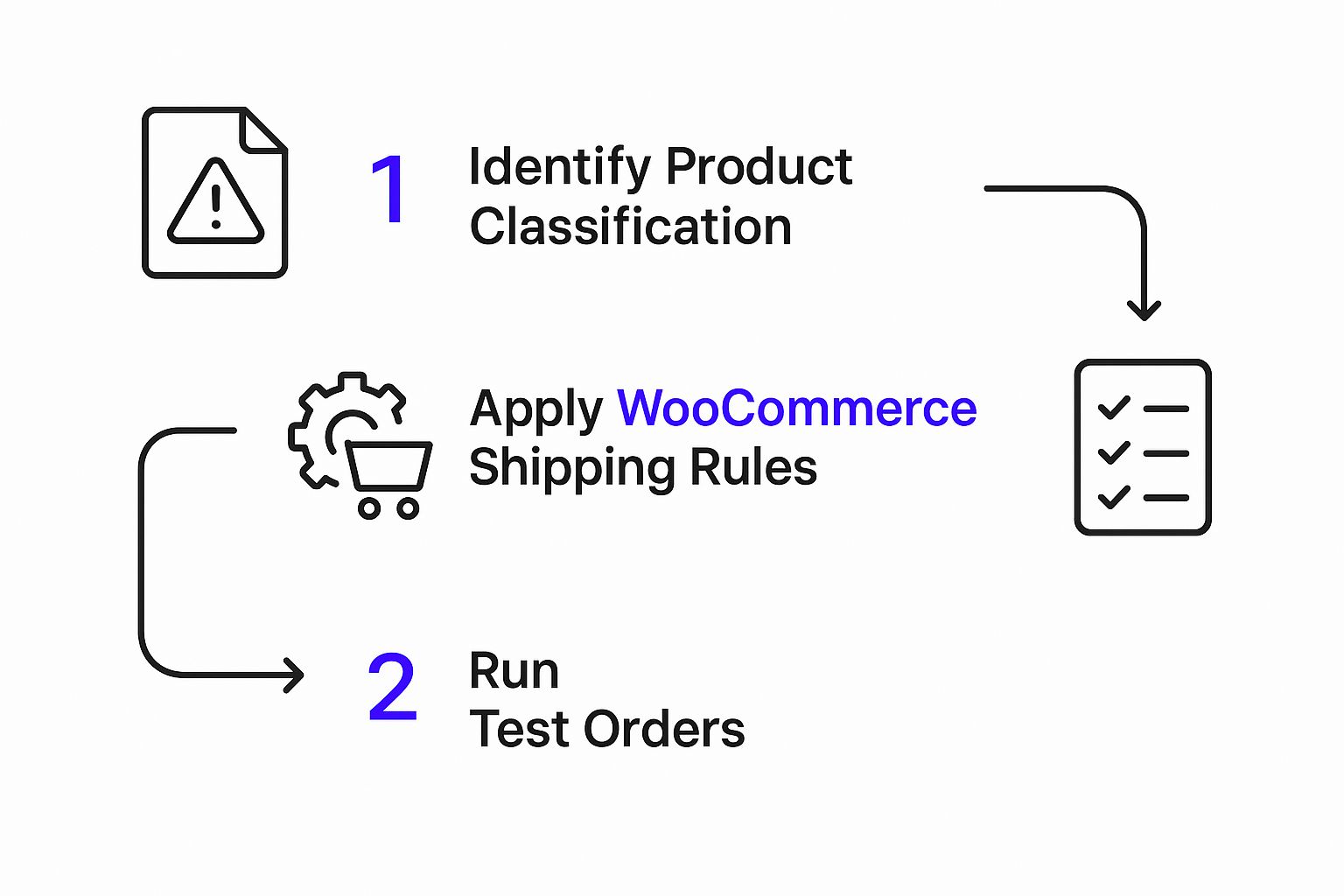
This visual shows the basic logic. The product's identity drives the shipping options, and testing confirms you got it right. Let's start building out some of these essential rules.
Disabling Air Shipping for Flammable Goods
One of the most common—and critical—rules you'll need is for flammable items. Think about products like perfumes, nail polish, or aerosol cans. For most e-commerce sellers, these are strictly forbidden on air cargo. One slip-up here can result in some seriously hefty fines from carriers.
Your rule needs to automatically scan the cart at checkout. If it finds a product tagged with the "Flammable Liquid" attribute you created earlier, it has to hide any air-based shipping methods.
- Rule Trigger: Product Attribute = "Flammable Liquid"
- Action: Hide shipping methods like "USPS Priority Mail Express," "FedEx 2Day," or "UPS Next Day Air."
This simple rule ensures customers can only choose ground services for these items, keeping you compliant with carrier and IATA regulations without you ever having to manually screen an order.
Blocking Shipments to Restricted Locations
Another crucial layer for managing hazmat shipping restrictions in WooCommerce is dealing with geographic limitations. Some states or even entire countries flat-out ban certain products. For instance, you might sell a powerful cleaning chemical that's illegal in a few specific jurisdictions.
Let's say you have a cleaner that's banned for sale in California and Hawaii. Your rule would look something like this:
Rule Scenario: Banned Chemical Cleaner If a product with the attribute "Corrosive" is in the cart AND the customer's shipping address is in California OR Hawaii, then hide ALL available shipping methods. It's also a good idea to show a custom message explaining why they can't complete the purchase.
This kind of multi-condition logic is incredibly powerful. It cross-references what the customer is buying with where they're shipping it, creating a precise, automated compliance check that runs every single time.
Preventing Hazmat Shipments to PO Boxes
Shipping hazardous materials to a Post Office Box is a major compliance trap. The USPS has very clear rules against it for most regulated goods. Trying to catch every "PO Box" address in your order queue by hand is a recipe for mistakes and wasted time.
A much better approach is to create a rule that looks for "PO Box" and its common variations in the address fields whenever a hazmat item is in the cart.
- Rule Trigger 1: Product Attribute = "Flammable Liquid" OR "Lithium Battery" OR "Corrosive"
- Rule Trigger 2: Shipping Address contains "PO Box," "P.O. Box," or "Post Office Box"
- Action: Hide all shipping methods and display a notice asking the customer to provide a physical street address.
The real challenge is that these regulations are always changing. For example, the International Air Transport Association (IATA) introduced new classifications for 2025, like creating UN 3551 specifically for sodium-ion batteries. With around 30% of global hazmat shipments crossing borders, staying on top of these updates is non-negotiable. You can dig into the details of these evolving standards to understand how they might affect your store. You can learn more about the latest IATA updates here.
Sustaining Compliance for the Long Haul
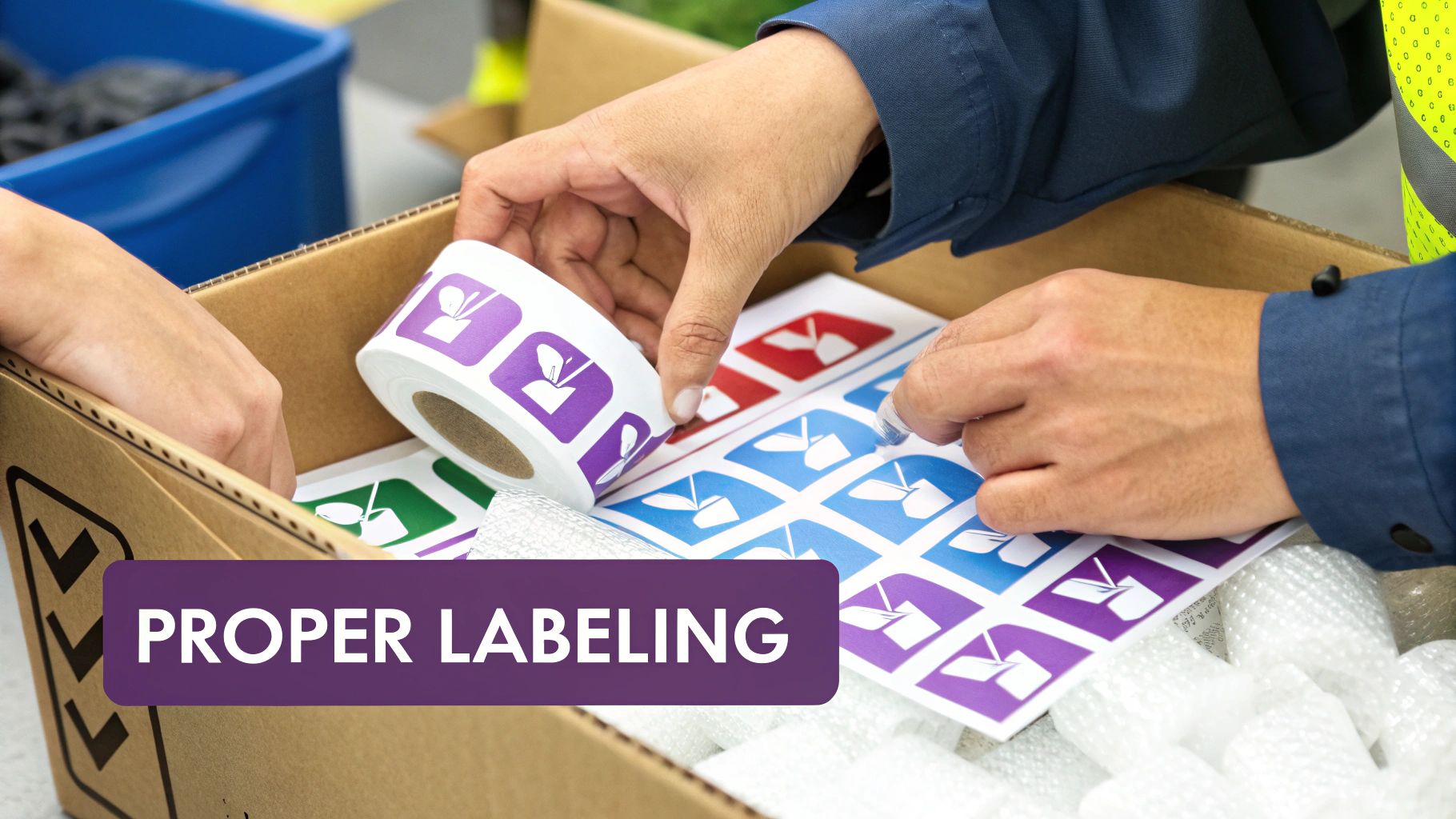
Successfully managing hazmat shipping restrictions in WooCommerce isn’t a one-and-done setup; it's an ongoing commitment. The rules you build today have to hold up against the regulations of tomorrow. This means you need a solid framework for sustaining compliance as your business grows and the regulatory landscape shifts.
Think of your shipping rules as a living system, not a static config file. Regulatory bodies like the DOT and IATA are constantly updating their requirements, adding new classifications, or changing packaging standards. A rule that’s perfectly compliant in January could be a violation by July. Building a scalable compliance system means you’re ready for these shifts from day one.
Performing Periodic Product Audits
Your first line of defense is a routine product audit. On a quarterly or semi-annual basis, comb through your entire catalog—paying extra attention to new additions—and make sure every item is correctly classified with the right hazmat attributes.
This process is absolutely critical when you bring on products from new suppliers. Never assume a new item is non-hazardous. Always verify its components and get your hands on a Safety Data Sheet (SDS) if there’s even a hint of doubt.
A common mistake is treating compliance like a project with a finish line. In reality, it’s a continuous cycle of auditing, updating, and training. That mindset shift is what separates businesses that thrive from those constantly staring down risk.
Staying Ahead of Regulatory Changes
Staying informed is non-negotiable. You have to subscribe to updates from major carriers and regulatory agencies. When a new rule is announced, you must be ready to translate it into your WooCommerce shipping logic.
- Monitor IATA & DOT: Keep an eye on their official publications for changes affecting the materials you sell.
- Update Ship Restrict Rules: If a chemical is suddenly restricted in a certain state, jump into your location-based rules and block those orders immediately.
- Communicate with Your Team: Make sure your fulfillment staff understands any new packing or labeling requirements that come from these changes.
Take a product like CBD oil, which faces a legal landscape that's constantly in flux, with rules that can change dramatically from one state to the next. Our guide on managing CBD and hemp shipping restrictions in WooCommerce shows just how vital it is to adapt to these regional curveballs.
The Critical Role of Team Training
Your automated rules are powerful, but your fulfillment team is the final checkpoint. They’re the ones physically packing the boxes and slapping on the labels.
Regular training ensures they understand why these rules exist and how to execute them flawlessly. It should cover specific handling instructions for each hazmat type you sell. Everyone involved must know the correct packaging, which labels to apply, and which shipping services are off-limits. This human element is the backbone of a truly resilient and compliant shipping operation that can grow safely with your business.
Frequently Asked Questions About WooCommerce Hazmat Shipping
<iframe width="100%" style="aspect-ratio: 16 / 9;" src="https://www.youtube.com/embed/aedgxya5nn8" frameborder="0" allow="autoplay; encrypted-media" allowfullscreen></iframe>Navigating the world of hazardous materials can bring up a lot of questions, especially when you're trying to get orders out the door. Here are some quick, clear answers to the most common queries we see from store owners trying to manage hazmat shipping restrictions in WooCommerce.
Can I Manage Hazmat Shipping Without a Specific Plugin?
Technically, you could try to cobble together a solution with custom code snippets to hide shipping methods. But from my experience, it's a fragile and high-risk approach for something as serious as hazmat compliance.
Code-based solutions are a nightmare to maintain, especially every time WooCommerce pushes an update. They also just aren't built to handle the complex, layered rules you often need, like blocking a specific carrier only when certain items are in the cart and going to a specific state.
A dedicated plugin gives you a reliable interface that’s easy to update as regulations change. More importantly, it drastically reduces the chance of making a costly compliance mistake.
What Happens If I Accidentally Ship a Hazmat Item Incorrectly?
The consequences can escalate quickly, and they're not pretty. At the very least, your carrier will probably return the package, delay it indefinitely, or even confiscate it. That's the best-case scenario.
More seriously, you could be looking at massive fines from regulatory bodies like the FAA or DOT. We're talking thousands of dollars, often per violation. Carriers might also suspend or just close your shipping account for good. In the absolute worst-case scenario where an accident happens, the legal and financial liability could be catastrophic for your business.
How Do I Handle Returns for Hazmat Products?
Hazmat returns are incredibly tricky. The biggest hurdle is that your customers aren't certified to ship dangerous goods, so you can't just email them a standard return label and call it a day.
Your return policy needs to be crystal clear and state one of two things:
- Non-Returnable: The item simply cannot be returned due to its hazardous classification.
- Special Process: The return requires a special pickup coordinated with a carrier that handles hazmat, which is often very expensive and complex to arrange.
Before you even think about offering returns on regulated items, talk to your shipping carrier. Understand their exact policies. This single step can save you from huge logistical and legal headaches down the road.
Ready to automate your compliance and eliminate these shipping mistakes for good? Ship Restrict provides the powerful, user-friendly tools you need to enforce complex hazmat rules directly within WooCommerce. Get Ship Restrict and start shipping with confidence today.

Cody Yurk
Founder and Lead Developer of ShipRestrict, helping e-commerce businesses navigate complex shipping regulations for regulated products. Ecommerce store owner turned developer.